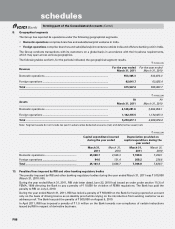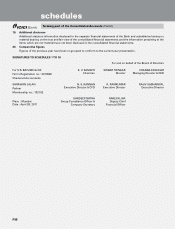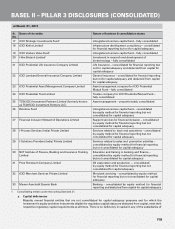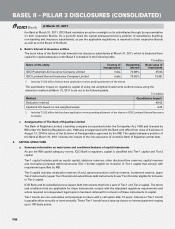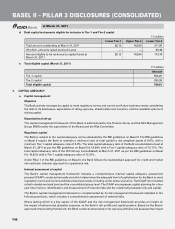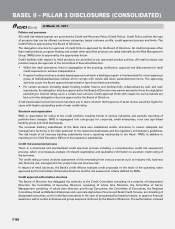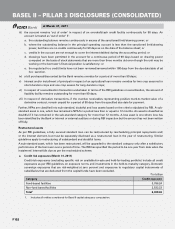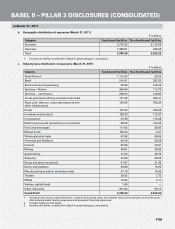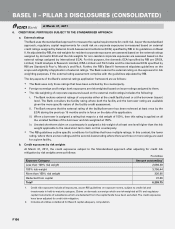ICICI Bank 2011 Annual Report Download - page 175
Download and view the complete annual report
Please find page 175 of the 2011 ICICI Bank annual report below. You can navigate through the pages in the report by either clicking on the pages listed below, or by using the keyword search tool below to find specific information within the annual report.
F97
on its capital ratios and the adequacy of capital buffers for current and future periods. The Bank periodically
assesses and refines its stress tests in an effort to ensure that the stress scenarios capture material risks as well as
reflect possible extreme market moves that could arise as a result of market conditions.
The business and capital plans and the stress testing results of the group entities are integrated into the ICAAP.
Based on the ICAAP, the Bank determines its capital needs and the optimum level of capital by considering the
following in an integrated manner:
• Bank’s strategic focus, business plan and growth objectives;
• regulatory capital requirements as per the RBI guidelines;
• assessment of material risks and impact of stress testing;
• perception of credit rating agencies, shareholders and investors;
• future strategy with regard to investments or divestments in subsidiaries; and
• evaluation of options to raise capital from domestic and overseas markets, as permitted by RBI from time to time.
The Bank formulates its internal capital level targets based on the ICAAP and endeavours to maintain its capital
adequacy level in accordance with the targeted levels at all times.
Monitoring and reporting
The Board of Directors of ICICI Bank maintains an active oversight over the Bank’s capital adequacy levels. On a
quarterly basis an analysis of the capital adequacy position and the risk weighted assets and an assessment of the
various aspects of Basel II on capital and risk management as stipulated by RBI, are reported to the Board. Further,
the capital adequacy position of the banking subsidiaries and the significant non-banking subsidiaries based on
the respective host regulatory requirements is also reported to the Board. In line with the RBI requirements for
consolidated prudential report, the capital adequacy position of the ICICI Group (consolidated) is reported to the
Board on a half-yearly basis.
Further, the ICAAP which is an annual process also serves as a mechanism for the Board to assess and monitor the
Bank’s and the Group’s capital adequacy position over a four year time horizon.
Capital adequacy of the subsidiaries
Each subsidiary in the Group assesses the adequate level of capitalisation required to meet its respective host
regulatory requirements and business needs. The Board of each subsidiary maintains oversight over the capital
adequacy framework for the subsidiary either directly or through separately constituted committees.
Basel III
In order to strengthen the resilience of the banking sector to potential future shocks, together with ensuring adequate
liquidity in the banking system, the Basel Committee on Banking Supervision (BCBS) issued the Basel III proposals
on December 17, 2009. Following a consultation phase on these proposals, the final set of Basel III rules were issued
on December 16, 2010. The Basel III rules on capital consist of measures on improving the quality, consistency
and transparency of capital, enhancing risk coverage, introducing a supplementary leverage ratio, reducing
procyclicality and promoting countercyclical buffers, and addressing systemic risk and interconnectedness. The
Basel III rules on liquidity consist of a measure of short-term liquidity coverage ratio aimed at building liquidity
buffers to meet stress situations and a measure of long-term net stable funding ratio aimed at promoting longer
term structural funding. BCBS has stipulated a phased implementation of the Basel III framework between January
1, 2013 and January 1, 2019.
Guidelines on Basel III framework for the Indian banking system are awaited from RBI. The Bank continues to monitor
developments on the Basel III framework and believes that its current robust capital adequacy position, adequate
headroom currently available to raise hybrid/debt capital, demonstrated track record of access to domestic and
overseas markets for capital raising and adequate flexibility in its balance sheet structure and business model will
enable it to adapt to the Basel III framework, as and when it is implemented.
BASEL II – PILLAR 3 DISCLOSURES (CONSOLIDATED)
at March 31, 2011



